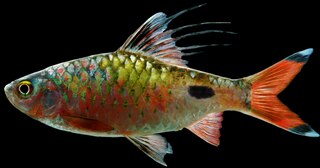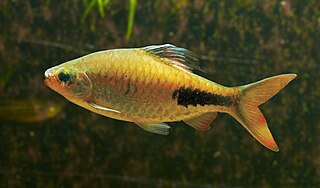
The black ruby barb or purplehead barb is a tropical cyprinid fish endemic to Sri Lanka, where it occurs in forested streams from the Kelani basin to the Nilwala basin. They are found in streams on hills around 1000 ft in elevation. The brightly colored population introduced to Mahaweli at Ginigathena, Sri Lanka, is said to have diminished in number due to the aquarium export trade.

The Denison barb, Denison's barb, Miss Kerala, red-line torpedo barb, or roseline shark is an endangered species of cyprinid fish endemic to the fast-flowing hill streams and rivers of the Western Ghats in India. It is commonly seen in the aquarium trade; pet collection caused it to become endangered and is its single major threat.

Puntius is a genus of small freshwater fish in the family Cyprinidae native to South Asia and Mainland Southeast Asia, as well as Taiwan.

The ticto barb or twospot barb is a species of subtropical freshwater fish belonging to the family Cyprinidae. It is a native of the upper Mekong, Salwen, Irrawaddy, Meklong and upper Charo Phraya basins in the countries of Nepal, India, Pakistan, Myanmar, Bangladesh, Thailand, and Sri Lanka. It has frequently been confused with the Odessa barb in the aquarium trade, but in that species the male is reddish-orange.

The Arulius barb is a tropical cyprinid fish native to the Kaveri River basin of south east India. Other common names include Tamiraparani barb, Silas barb and longfin barb.
Pethia bandula, commonly known as bandula barb, is a species of cyprinid endemic to Sri Lanka where it is only known from near Galapitamada in the Warakapola Divisional Secretariat. As this critically endangered species only was known from a single unprotected site where the population consists of an estimated 1,000 individuals, a second "insurance population" was established in 2014 by a team of IUCN scientists in cooperation with Sri Lanka's Forest Department, the Department of Wildlife Conservation and local communities.
Pethia cumingii, known as the Cuming's barb or the two spot barb, is a species of cyprinid fish endemic to Sri Lanka.

Dawkinsia filamentosa, the filament barb, or poovali paral is a species of barb. Young fish have barely any color and black spots. They start having more color at three months old. The fish is a swift swimmer. Males are larger than females and they fertilize eggs by swimming into the cloud of eggs. The species is most commonly found in coastal floodplains near the Southwest Indian states of Kerala, Tamil Nadu and Karnataka. This species is also known as blackspot barb.

Dawkinsia assimilis is a species of ray-finned fish in the genus Dawkinsia. It is endemic to the southern Western Ghats especially to the Southwest Indian states of Karnataka and Kerala. They are known as Mascara Barb. Filament barbs are a group of small freshwater fishes found in the rivers of peninsular India and Sri Lanka. There are nine species known under the genus Dawkinsia. These barbs are popular among aquarium hobbyists as an ornamental fish and are also collected from rivers and bred for trade.
Dawkinsia chalakkudiensis is a species of cyprinid fish endemic to the Chalakkudy River, Kerala, India in the Western Ghats where it can be found in well-vegetated upper reaches of rivers. This species can reach a length of 12.5 centimetres (4.9 in) TL. It resembles the related D. denisonii, but the colours of D. chalakkudiensis are less intense.
The Channa barb is a species of ray-finned fish belonging to the family Cyprinidae, the family which includes the carps, barbs and related fishes. It is the only species in the monospecific genus Eechathalakenda, although this species was formerly placed in the genus Puntius. This species is endemic to the Western Ghats in southern India.

Dawkinsia singhala is a species of ray-finned fish in the genus Dawkinsia. It is found in Sri Lanka. The genus Dawkinsia is named after evolutionary biologist Richard Dawkins.

Dawkinsia srilankensis, the blotched filamented barb, is a species of ray-finned fish in the genus Dawkinsia. This species is endemic to the Kalu River in Sri Lanka and it is in imminent danger of going extinct due to tailings from upstream mines and potentially also capture for the aquarium trade. It was bred recently in the Dehiwala Zoological Gardens.

Dawkinsia tambraparniei is a species of cyprinid fish found in the Tambraparni River basin in the Western Ghats, Tamil Nadu, India. This species can reach a length of 12.8 centimetres (5.0 in) SL.

Rohan David Pethiyagoda is a Sri Lankan biodiversity scientist, amphibian and freshwater-fish taxonomist, author, conservationist and public-policy advocate.

Dawkinsia is a genus of cyprinid fishes from freshwater in South India and Sri Lanka. It was split off from genus Puntius in 2012.

Pethia is a genus of small freshwater fish in the family Cyprinidae native to South Asia, East Asia and Mainland Southeast Asia. Some species are commonly seen in the aquarium trade. The name Pethia is derived from the Sinhalese "pethia", a generic word used to describe any of several small species of cyprinid fishes. Most members of this genus were included in Puntius, until it was revised in 2012.

Haludaria is a genus of cyprinids native to freshwater habitats in the Western Ghats of India. Originally the genus was named DravidiaPethiyagoda, Meegaskumbura & Maduwage, 2012 which is preoccupied by the dipteran genus DravidiaLehrer, 2010.
Puntius khohi is a species of fish in the family Cyprinidae in Puntius genus. The species was discovered in 2004, named and described by Dobriyal, R. Singh, Uniyal, H. K. Joshi, Phurailatpam & Bisht, of Gharwhal University in Uttaranchal, India in 2004. The study and paper on Puntius khohi was published in the Journal of the Inland Fish Society the same year (2004). It was collected from a stream called "Sil Gad" which originates from the western slopes of Kalondanda southeast of Lansdowne in the foothills of the Himalayas. The specific name khohi refers to the river in which the Sil Gad stream joins.
Dawkinsia uttara, the northern filament barb, is a species of freshwater fish belonging to the family Cyprinidae.














